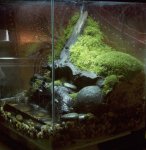damien
Member
- Joined
- May 7, 2007
- Messages
- 199
- Reaction score
- 5
- Points
- 18
- Age
- 40
- Location
- Leiden, Netherlands
- Country
- Netherlands
- Display Name
- Danny
I'm wondering, is the sphagnum moss that is sold in those compressed blocks any good for in a terrarium? I'd like to make a nice green terrarium, so I wonder if those blocks become green eventually or if they remain that brownish color. Anyone know?
The 'normal' moss that is sold here is filled with dead Pine 'needles', and that looks horrible. It's way too much to manually remove, so those blocks look like the best solution for me.
The 'normal' moss that is sold here is filled with dead Pine 'needles', and that looks horrible. It's way too much to manually remove, so those blocks look like the best solution for me.

